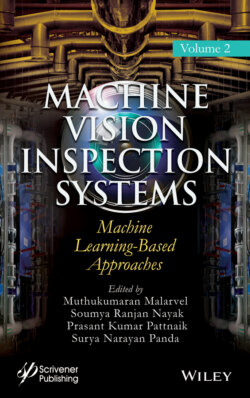Читать книгу Machine Vision Inspection Systems, Machine Learning-Based Approaches - Группа авторов - Страница 29
2.3.4 Training Process
ОглавлениеThe learning model is trained on an AWS EC2 instance consists of four vCPUs and Nvidia Tesla V100 GPU with 16GB memory. We trained our models up to 500 epochs while manually adjusting the learning rate depending on the convergence.
Before the model training, images were coupled. For the images of the same category, the expected prediction is 1 and for others 0. Data fetching is done on the CPU, at the same time they are fed and processed in the GPU. This significantly reduced the training time.
Algorithm 1 states the data generation process for model training. The process takes the category list of the characters and the images that belong to each category as the inputs. This process generates the image couples and the expected output values as output. The process starts with generating similar couples. As stated in line 1, the loop goes through each character category and generates the couples belonging to the same category, as given in the get_similar_couples function in line 2. These image couples are added to the output array training_couples in line 3, along with the expected value as given in line 4. For the matching image couples, the prediction is one, hence number 1 is added to the expected values array for the count of couples.
In lines 5 and 6, the algorithm loops through category list for two times, and check for the similar categories in line 7. If the two categories are the same, the process immediately goes to the next iteration of the loop, using the continue keyword in line 8. If there are different categories, then the process generates the mismatching image couples from the category images in each of the considered categories, as given in line 9. Then the image couples are added to the training_couples array. Since these are the false couples, the prediction should be zero. Thus, in line 11, the value 0 is added to the expected values array for the same length of the image_couples array.
After that, in line 12, the output arrays are shuffled before the training model, to generate random training samples.
Algorithm 1: Data generation
Input: cat_list[], category_images [] Output: training_couples[], expected_values[] 1. for (category in cat_list[]) 2. image_couples = get_similar_couples
(category_images[category]) 3. traing_couples.add(image_couples) 4. expected_values.add([1] * image_couples.length) 5. for (category1 in cat_list[]) 6. for (category2 in cat_list[]) 7. If (category1 == category2) 8. Continue 9. image_couples=get_different_couples
(category_images[category1],category_images[category2]) 10. training_couples.add(image_couples) 11. expected_values.add([0] * image_couples.length) 12. Shuffle (training_couples, expected_values) 13. return training_couples[], expected_values []
